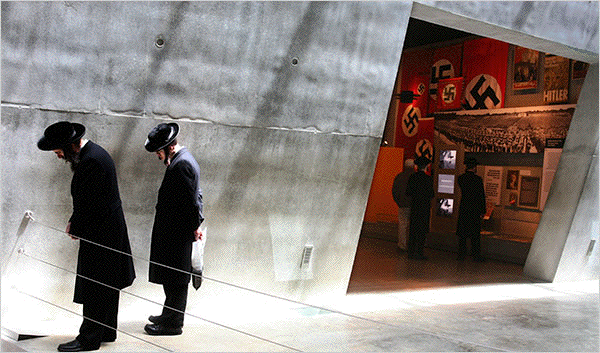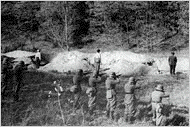
|
Visitors
at the International Institute for Holocaust
Research at Yad Vashem, where research is being
done on lesser-known killing fields.
The focus is on the various killings of Jews
across the former Soviet Union.
|
New
Looks at the Fields of Death for Jews
During the Holocaust Years
By ETHAN
BRONNER
April 19, 2009
JERUSALEM -- In
the Ukrainian town of Berdichev, Jewish women were forced
to swim across a wide river until they drowned. In
Telsiai, Lithuania, children were thrown alive into pits
filled with their murdered parents. In Liozno, Belarus,
Jews were herded into a locked barn where many froze to
death.
Holocaust deniers
aside, the world is not ignorant of the systematic Nazi
slaughter of some six million Jews in World War II.
People know of Auschwitz and Bergen-Belsen; many have
heard of the tens of thousands shot dead in the Ukrainian
ravine of Babi Yar. But little has been known about the
hundreds, perhaps thousands, of smaller killing fields
across the former Soviet Union where some 1.5 million
Jews met their deaths.
That is now
changing. Over the past few years, the Yad Vashem
Holocaust museum and research center in Israel has been
investigating those sites, comparing Soviet, German,
local and Jewish accounts, crosschecking numbers and
methods. The work, gathered under the title "The Untold
Stories," is far from over. But to honor Holocaust
Remembrance Day, which starts Monday evening, the
research is being made public on the institution's Web
site.
"These are places
that have been mostly neglected because they involved
smaller towns and villages," said David Bankier, head of
the International Institute for Holocaust Research at Yad
Vashem. "In many cases, locals played a key role in the
murders, probably by a ratio of 10 locals to every one
German. We are trying to understand the man who played
soccer with his Jewish neighbor one day and turned to
kill him the next. This provides material for research on
genocide elsewhere, like in Africa."
|

|
|
|
Jews
executed in October 1941 in Serbia. One goal of
the Yad Vashem project is to learn more exactly
how many were killed.
|
For the
purposes of this project, a killing field entails at
least 50 people, said the project director, Lea Prais.
The killing began in June 1941 with the German invasion
of the Soviet Union. From the Baltic republics in the
north to the Caucasus in the south, Nazi death squads
combed the areas.
The first
evidence for what took place was gathered right after the
war by Soviet investigating committees largely focused on
finding anti-Soviet collaborators.
The new research
checks that evidence against German records, diaries and
letters of soldiers, as well as accounts by witnesses and
the few surviving Jews, some of whom climbed out of pits
of corpses. Sometimes, the researchers said, the Soviets
seemed to have exaggerated, and that is noted on the Web
site. One goal of the project is to learn more exactly
the numbers killed.
One little-known
case comes from a German sailor who filmed killings in
Liepaja, Latvia. The film has been on view for some years
at the Yad Vashem museum. But the new Web site has a
forgotten video of a 1981 interview with the sailor,
Reinhard Wiener, who said he had been a bystander with a
movie camera.
According to part
of his account, "After the civilian guards with the
yellow armbands shouted once again, I was able to
identify them as Latvian home guardsmen. The Jews, whom I
was able to recognize by now, were forced to jump over
the sides of the truck onto the ground. Among them were
crippled and weak people, who were caught by the
others.
"At first, they
had to line up in a row, before they were chased toward
the trench. This was done by SS and Latvian home
guardsmen. Then the Jews were forced to jump into the
trench and to run along inside it until the end. They had
to stand with their back to the firing squad. At that
time, the moment they saw the trench, they probably knew
what would happen to them. They must have felt it,
because underneath there was already a layer of corpses,
over which was spread a thin layer of sand."
Ms. Prais said
one of the discoveries that had most surprised her was
the way in which Soviet Jews who survived the war made an
effort to commemorate those who had perished. In distant
fields and village squares they often placed a Star of
David or some other memorial, despite fears of overt
Jewish expression in the Soviet era.
"The silent Jews
of the Soviet Union were not so silent," she
said.
The slaughter
that some of them had escaped defies the imagination. One
case Ms. Prais and her colleagues have cross-referenced
involves what happened in the town of Krupki, Belarus,
where the entire Jewish community of at least 1,000 was
eliminated on Sept. 18, 1941.
A German soldier
who took part in the mass killing kept a diary that was
found on his body by the Allies, she said. In it, he
wrote of having volunteered as one of "15 men with strong
nerves" asked to eliminate the Jews of Krupki. "All these
had to be shot today," he wrote. The weather was gray and
rainy, he observed.
The Jews had been
told they were to be deported to work in Germany, but as
they were forced into a ditch, the reality of their fate
became evident. Panic ensued. The soldier wrote that the
guards had a hard time controlling the crowd.
"Ten shots rang
out, 10 Jews popped off," he wrote. "This continued until
all were dispatched. Only a few of them kept their
countenances. The children clung to their mothers, wives
to their husbands. I won't forget this spectacle in a
hurry...."